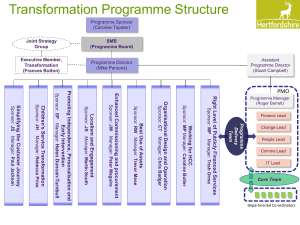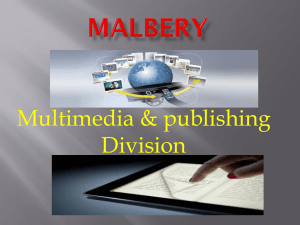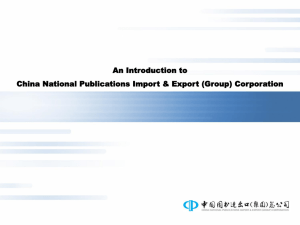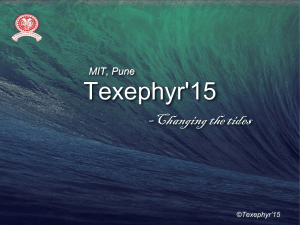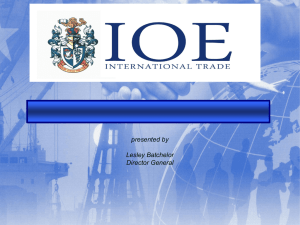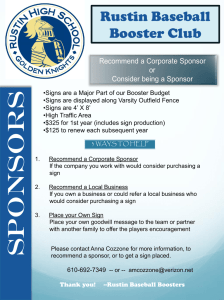Session 12 - Fundamentals of Contract Negotiation
advertisement
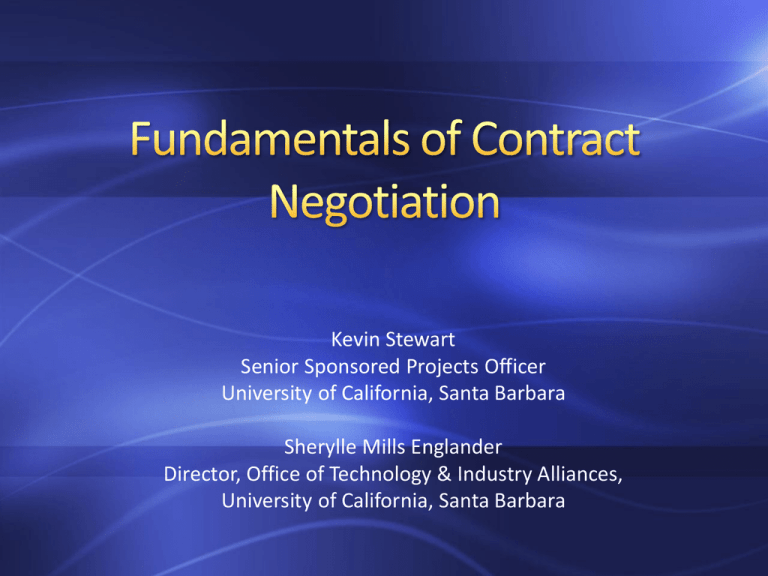
Kevin Stewart Senior Sponsored Projects Officer University of California, Santa Barbara Sherylle Mills Englander Director, Office of Technology & Industry Alliances, University of California, Santa Barbara Why are negotiations and issues so different when working with each of them? • Assure basic, early stage research of national importance occurs – Health, environment, energy, agriculture, e.g. – Companies cannot recapture full cost of large scale, long term (20 – 40 year) basic research projects • Maintain U.S. military and defense superiority • Maintain/spur healthy economy – By assuring U.S. remains the technology leader of an important market – By providing early stage support to small businesses and start up companies. RESPONSIBILITY TO BENEFIT THE U.S. AND ITS CITIZENS • To gain/maintain competitive advantage – to solve specific research challenges that will enable next generation products/broaden market and sales – to gain (or accelerate) specific regulatory approvals for new products • To locate top students for hiring – Provides a chance to test the capabilities of a researcher before hiring them formally • To fund strategic, high risk research economically – They only pay the actual costs of research (i.e., only 5% of a researcher’s salary if they use only 5% of the time) RESPONSIBILITY IS TO THEIR SHAREHOLDERS/FINANCIAL SUCCESS • Grant – Assistance Mechanism (T&Cs are based on OMB Circular A-110) • Cooperative Agreement – Assistance Mechanism (more restrictive T&Cs, as Feds expect more involvement (but still A-110-based)) • Contract – Procurement Mechanism (requires specific deliverables; T&Cs are from the Federal Acquisition Regulations (FAR)) • Others… – Other Transaction Agreement • Used for research or prototypes; not FAR-based – CRADA (Cooperative Research and Development Agreement) • Used between Federal labs and other entities; not FAR-based • Research Agreement – Company agrees to pay the costs of a specific scope of work • Material Transfer Agreements – Company (or university) agrees to share scientific material for use in research, usually at no cost • Non-Disclosure Agreement – Company asks University to agree to keep certain information disclosed by the company confidential • License Agreement – Company seeks to use university-owned intellectual property in commercial products. • Gifts – Company provides unrestricted, “no strings” philanthropic support to a research group BEWARE OF ONE TYPE OF ARRANGEMENT MORPHING INTO ANOTHER!! – Funding will start as a gift. . . with strings slowly creeping in or being required through separate agreement • i.e., gift itself has no conditions, but “company policy” requires signature on IP agreement to issue any check, regardless of type – A material transfer agreement will suddenly have a payment or purchase order attached to it • Method for sponsor research and get IP rights without paying indirect costs • University Interest: – To publish publications at the earliest opportunity in order to encourage further advancements in science, increase profile of department, attract further funding and enhance university reputation. • Faculty/Student Interest: – To publish often and with large impact in the best journal possible, in order to receive promotions and tenure (faculty) or jobs (student), and receive international credit for important work that they did. • Not all sponsors perceive benefits from publication – Government/Nonprofit: publication consistent with their mission of improving the lives of the public through research; helps demonstrate impact of funded research in budget discussions • Note: BEWARE of publication restrictions in Federal contracts – indicative of presumption that research is export-controlled (covered in next section…) – For-Profits: information in open publications benefits both themselves and their competitors – can be a sensitive point. Companies face great pressure to watch “bottom line” and preserve competitiveness for investors/shareholders. Some prefer no publication. • Sponsor’s Specific Concerns: – Prefer nothing is published without their approval so competitors do not get access. (cannot accommodate) – If publication is to occur, Sponsor worries about: • Sponsor’s own trade secrets being destroyed when revealed in university publication (fair enough) • Publication will describe an important invention developed in the research, significantly injuring patent rights they would like to license (university shares concern, if we own) • Sponsor may find out “third hand” about funded research (insulting to Sponsor) A Good Publication Clause: • Affirms University right to use any data/information that it develops during research • Provides Sponsor with brief “review” period (not approval, not consent) of no more than 90 days total. • May agree to: – Delete any trade secret of sponsor that is mistakenly included – Delay publication for another brief period of time to allow patent application to be filed (with mutual agreement). • Alert! University should not agree to make any editorial changes requested (i.e., remove interpretations, conclusions, sets of data, rephrase language, etc.) • Assure delay is brief (typically no more than 90 days!) – Research falls out of “Fundamental Research Exemption” under export control laws if there are restrictions on publication beyond brief, pre-publication review for trade secrets/patentable inventions(see, e.g., 15 CFR Sec. 734.8.) • Remember, a student thesis, not just journal articles, are considered publications – Extensive delays can literally delay a degree, and thus, put a student’s first job at risk. • A patent application can be filed in less than one week (24 hours if necessary) • A set of federal laws (EAR and ITAR) managed by the Department of Commerce aimed at controlling the disclosure/transfer of certain sensitive technology and technical data to foreign persons – Drafted very broadly – can even cover a laptop brought along on travel! – Restrictions can vary depending on the country – Includes concept of “deemed” export –where a technology is exported just by being viewed by a foreign person in the U.S.! • If something is “export controlled” you must secure a license from the federal government before exporting it (including deemed export) • Universities are highly porous, decentralized environments. – Disclosure of information is common – Very little compliance oversight in laboratories • Universities have high percentages of foreign persons hired as faculty or enrolled as a student – 40% of UCSB graduate students are foreign persons • Even if we could learn of potential disclosure – Limited resources and manpower to apply for a license “University shall apply with all applicable export control laws.” – Seems harmless, but is it?? • Basic and applied research conducted at an accredited U.S. university is exempt from export control regulation, as long as it is ordinarily published and shared broadly with the scientific community. – Can be subject to short (i.e, 60-90 day) publication delays to assure no patentable inventions or trade secrets are included. – Cannot agree to restrict foreign persons from viewing • Source of Exemption: National Security Decision Directive (NSDD) 189 SO, IF WE ARE EXEMPT, WHAT’S THE PROBLEM? • To ensure that research falls under the Exemption, make sure that – Contract does not restrict publication/dissemination – Contract does not restrict participation to U.S. Citizens • Note: – Some Federal agencies will include restrictions because they do not consider the work to fall under the Exemption • Example: DARPA use of 6.3 appropriations for funding • Common hurdle in Industry contracts that are Fed flowthrough • Fundamental research exemption applies ONLY to university generated data. – If the industry partner gives us export controlled information, we must follow export control laws regarding that information – Even if it was given without the consent of the university and without the knowledge of university administrators • Position One: Negotiate it out. – State that the university does not accept export controlled information. We cannot sufficiently monitor research. – Sometimes it is necessary to revise the University scope of work so the research will not require the use of export controlled information. • Position Two: Require Advance Approval. – Require the advance notification, and approval of, the export control compliance officer before company can send export controlled information – Obtain informed consent of university researchers A Whole Different Class, To Start. . . • Never give up title!! – The person that owns controls use! • Only give rights to intellectual property developed wholly on that agreement! – Not “arising from” the agreement – Not “made during the term of” the agreement – Avoid background intellectual property obligations • ENLIST THE HELP OF YOUR TECH TRANSFER OFFICE – They have to live with the terms you set – so they are motivated to help! • Bayh-Doyle Act establishes the standard patent rights for Fed-funded research (codified in 37 CFR 401) – University retains title – Feds get a non-exclusive, royalty-free license to inventions conceived OR reduced to practice in performance of research – Any abstractions from Bayh-Dole standard require a Declaration of Exceptional Circumstances by the Federal Agency • Industry is NOT entitled to same rights from University as Feds in subcontracts – Bayh-Dole establishes that contractor cannot “as part of the consideration for awarding the subcontract, obtain rights in the subcontractor’s [inventions]” • IP License to Industry for “conceived OR reduced to practice” NOT the same as for Feds • The period of performance is a key element in a contract – When does the contract start and when does it end? – Creates points in time for terms and conditions. • Payment and invoicing • Reports and deliverables • INDUSTRY ALERT!! There are NO 90 day pre-award costs on contracts (for-profit OR Federal)! – You may need to back date to get reimbursement for spent funds – Reports due dates often are written as specific dates – you don’t want a technical report due just two weeks after signing! • Use timing of payments to protect the University from collection issues. When possible, – Require small or short term contracts to be paid in full upon execution of agreement (or within 7-30 days of signing) – Require large or long term contracts to provide advance payments annually, semi-annually or quarterly. • University’s goal is to get as much funding as possible in advance in case an sponsor gets funding cut or goes out of business. It is much better to be holding the money when in a dispute or dealing with a default!! • Make sure your termination clause: – Allows University to terminate for any reason – Requires the terminating party to give notice • Allows research team to task down – Requires company to pay all actual costs • NOT – percentage of contract price based on work performed – Requires company to pay any noncancelable costs • That $50K nonrefundable deposit on equipment not yet delivered! • In a nutshell: A contractual promise that one party will defend the other party, and pay all damages against that party (attorneys fees, settlements, judgments, etc.) if something happens. – If I borrow your car, I promise to repair any damage and, if I hit someone who then sues you, I will pay for your legal costs and pay any judgments or settlements against you. • Only indemnify for acts done by your university – Not acts by sponsor – Not acts by third parties • Only to the extent permitted by law • Only to the extent your university is liable • Only in proportion to your university’s liability To the fullest and complete extent of the law, University defends, holds harmless and indemnifies Sponsor and its officers, employees, agents, affiliates and representatives from and against any and all claims, demands, suits, judgments liabilities, causes of action, losses, expenses, damages, fines or penalties, including reasonable attorneys fees and charges (collectively, “Claims”) of any person not a party to this agreement, arising or resulting from, or occasioned by (i) anyact or omission by University or its officers, employees, agents or affiliates with respect to this Agreement or (ii) violations of any applicable law by University or its officer, employees, agents or affiliates. To the fullest and complete extent of the law, University defends, holds harmless and indemnifies Sponsor and its officers, employees, agents, affiliates and representatives from and against any and all claims, demands, suits, judgments liabilities, causes of action, losses, expenses, damages, fines or penalties, including reasonable attorneys fees and charges (collectively, “Claims”) of any person not a party to this agreement, arising or resulting from, or occasioned by (i) any act or omission by University or its officers, employees, agents or affiliates with respect to this Agreement or (ii) violations of any applicable law by University or its officer, employees, agents or affiliates. Some common sense ideas. • Universities have multiple personalities and motivations in any negotiation: – – – – – Faculty Sponsored Projects Technology Transfer Senior Administrations Central Administration • University negotiators need to understand which stakeholders the agreement will affect, how they are motivated, and how to build internal unity on campus in case things get tense • For particularly tough ones, meet in advance with senior administration (VPs, Deans) to understand the boundaries and get support for important positions. • With respect to your industry partner, understand: – Basic industry sector and established norms – Size/culture of organization • Company’s website is a wealth of information – look at the facts, as well as how they describe themselves and their goals – Past history with your university – Past history with other universities Review Agreement immediately. If not ideal, call the researcher – State up front it may take time so they can plan – What kind of project is it and how does the type potentially mitigate the proposed terms? – Any close relationships for insight on company policy/culture and for advocacy? – Analyze the terms • Why do you need to push back? What, fundamentally, do you need for each issue to resolve? • If the terms of the agreement are atrocious, or don’t make sense, ask yourself DID THEY SEND THE RIGHT AGREEMENT? • Often, the overworked negotiator will send the closest thing in the hard drive – which may be a template for the purchase of pencils, or perhaps the template for hiring individuals as consultants. – Don’t be afraid to send your research agreement, instead of changes, and ask that it is used as a basis for the agreement! It will save time. • Get to know the personality/circumstances of the industry negotiator (authority, experience, personality, incentives, workload) – The more you know the more you can where to educate and how to help them say “yes.” • Be both personable and respectful. – People are more likely to say “yes” to someone they like! • Tell them both why you need the change, and send them the exact language you would like. – People are more likely to say “yes” if you do their work for them! • Know why a term is important to the other side – If you know the “why”, you can craft a solution that protect you, but meets their needs. – Begin by negotiate to accommodate the interests of each side and find common ground, NOT specific language. • If the term is broad, consider asking the other side exactly why they need the term – If they admit to a precise purpose, you can narrow the language to *only* apply to that specific purpose • Know what the other side’s interests are – Pick arguments that address their interests and concerns! • COMMUNICATE INTERNAL LANDSCAPE TO OTHER SIDE • Universities have intricate delegations of authority – Univ. negotiators need to communicate these delegations clearly to the industry partner early on, to maintain credibility during negotiation • Universities have set rules and policies. University negotiators must: – Understand why the rules are what they are to understand where flexibility lies – Know not only who can grant exceptions, but be able to predict how the exception authority will likely view a given situation and what conditions to expect; informally discuss special situations early, before significant time is invested • Resist the urge to feel that industry-proposed terms are stupid, malicious or evil – Show respect for their requests – Companies exist in a very different environment and, in most cases, their positions make very logical sense in their world. • Take time to educate your counterpart – this may be their first interaction with a university or your policies and they may be unaware of our differences from companies. • Don’t be afraid to bring in the “gray hair” – sometimes the same argument said by the “Director title” magically works – don’t fight it, just use it to your advantage. • Pick the most credible argument for the audience
